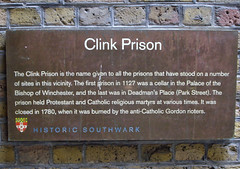The Clink
place and prison
Aged unknown
Wikidata WikipediaThe Clink was a prison in Southwark, England, which operated from the 12th century until 1780. The prison served the Liberty of the Clink, a local manor area owned by the Bishop of Winchester rather than by the reigning monarch. As the Liberty owner, the Bishop kept all revenues from the Clink Liberty, and could put people in prison for failing to make their payments. As the Bishop, he could also imprison heretics. The Clink prison was situated next to the Bishop's London-area residence of Winchester Palace. The Clink was possibly the oldest men's prison and probably the oldest women's prison in England. It is uncertain whether the prison derived its name from, or bestowed it on, the Liberty that it served. The origins of the name "The Clink" are possibly onomatopoeic, deriving from the sound of striking metal as the prison's doors were bolted, or the rattling of the chains the prisoners wore. The name has become slang as a generic term for prison or a jail cell.
DbPedia
Commemorated on 2 plaques
The Clink. Most notorious medieval prison
Clink Prison Museum, Soho Wharf, Clink Street, London, United Kingdom where it sited
Clink Prison. The Clink Prison is the name given to all the prisons that have stood on a number of sites in this vicinity. The first prison in 1127 was a cellar in the Palace of the Bishop of Winchester, and the last was in Deadman's Place (Park Street). The prison held Protestant and Catholic religious martyrs at various times. It was closed in 1780, when it was burned by the anti-Catholic Gordon rioters.
Clink Prison Museum, Soho Wharf, Clink Street, London, United Kingdom where it sited
